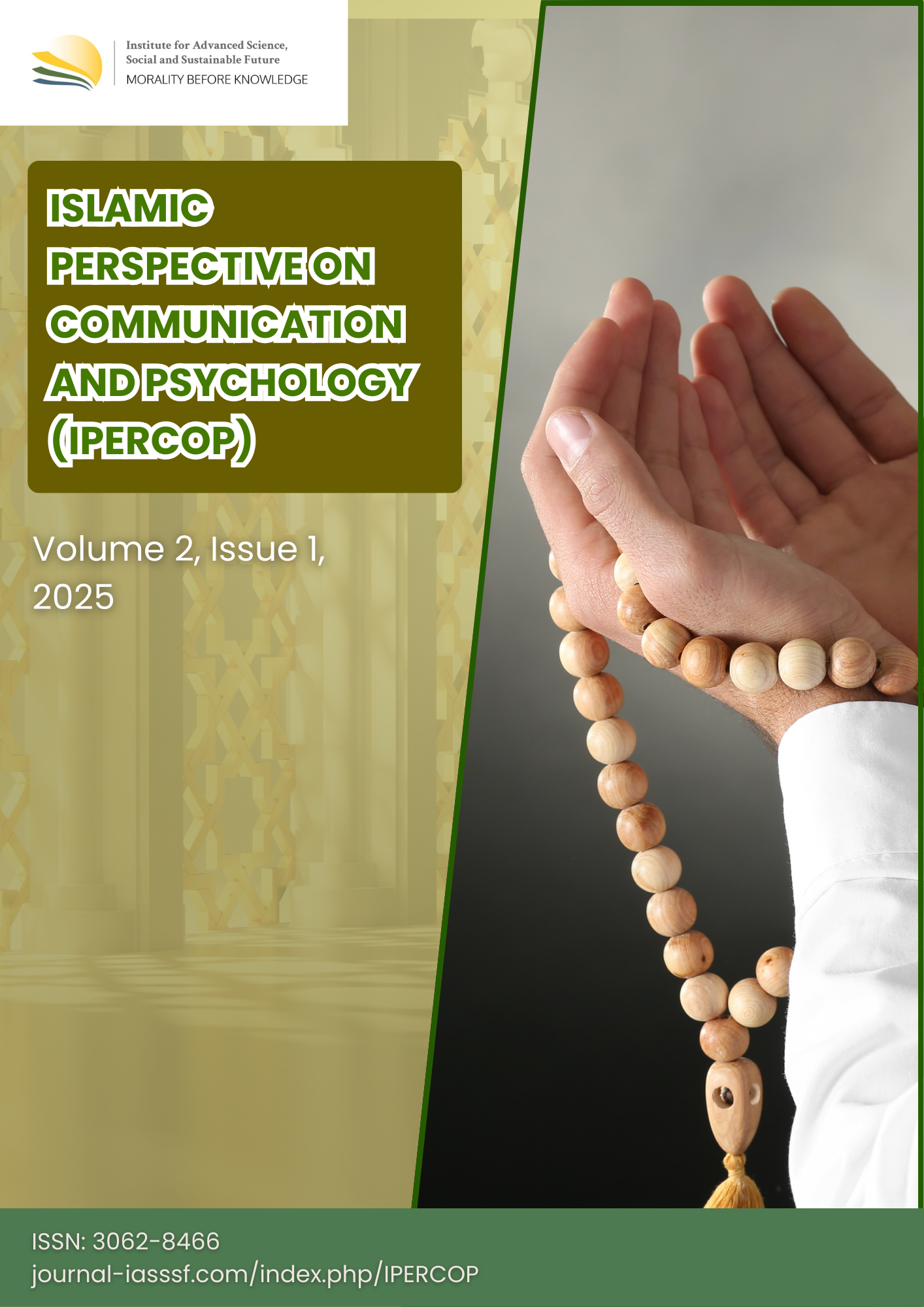Commodification of religion and islamic cultural industry through social media
DOI:
https://doi.org/10.61511/ipercop.v2i1.2025.1644Keywords:
commodification of religion, culture, fashion, social mediaAbstract
Background: WEF (World Economic Forum) data in 2022 shows an increase in the number of hijab users in Indonesia by 5.7%. It seems that easily accessible social media is one of the factors influencing the growth of the fashion industry. because anyone can see, create and even spread ideas, concepts and works with various purposes. Methods: This study employs a qualitative approach with content analysis of social media platforms, interviews with Muslim celebrities, and literature reviews on the commodification of religion and fashion trends. Data collection focuses on identifying the motives behind hijab fashion promotion and its impact on public perception. Findings: The Islamic cultural industry creates opportunities for the commodification of religion, particularly through the fashion industry in Indonesia. Muslim celebrities use social media to influence hijab fashion trends, which carry both positive and negative meanings. Social media serves as a platform for interaction, inspiration, and sharing experiences, making hijab fashion more modern and increasingly secular. Conclusions: The study finds that social media plays a crucial role in shaping hijab fashion trends in Indonesia, driven by the dual motives of Muslim celebrities—ranging from attraction and inspiration to existential expression. This phenomenon reflects the commodification of religion, where hijab fashion is increasingly modernized and secularized, blurring traditional religious boundaries and reinforcing consumer-driven identities. Novelty/Originality of This Study: The novelty of this study lies in its exploration of the dual motives of Muslim celebrities in shaping hijab fashion trends through social media, highlighting the commodification of religion and the evolving modern-secular interpretation of hijab.
References
Banindro, B.S. (2018). Introduction to Kapita Selekta. BPISI.
Bayu D. (2021). As many as 86.9% of the Indonesian population is Muslim. https://dataindonesia.id/ragam/detail/sebanyak-869-penduduk-indonesia-beragama-islam
Boulanouar, A. W. (2006). The idea of modesty in Muslim women's clothing: an Islamic point of view. Journal of Asian Studies New Zealand, 8(2), 134-156. https://www.nzasia.org.nz/uploads/1/3/2/1/132180707/9boulanouar2b.pdf
Cangara, H., & Risnayanti, B. (2011). Hijab as a Symbol of Communication among Hasanuddin University Students. Kareba Journal of Communication, 1(2), 149-176. https://journal.unhas.ac.id/index.php/kareba/article/view/305
Dar Alifta. (2022). How did Niqab (veil) become a habit in Muslim society?. http://www.dar-alifta.org/Foreign/ViewFatwa.aspx?ID=6766
Desai, M. E. (2006). The Opinion of Ulama/Fuqaha Following the Face Covering/Niqab. http://askimam.org/public/question_detail/13998.html
Desianti, M. (2017). Ivan released a new label Manjha Hijab Ivan Gunawan. Wedingku.Com. https://www.weddingku.com/blog/ivan-merilis-label-baru-manjha-hijab-ivan-gunawan
Duffy, B. E., & Hund, E. (2015). “Having it all” on social media: Entrepreneurial femininity and self-branding among fashion bloggers. Social media+ society, 1(2), 2056305115604337. https://doi.org/10.1177/2056305115604337
Farhan., & Islamiyah, F. (2019). Komodifikasi Agama Dan Simbol Keagamaan ‘Jilbab’ Di Media Online Dalam Persepsi Netizen. At-Tahdzib: Jurnal Studi Islam Dan Muamalah, 7(1), 51-69. https://ejournal.staiat-tahdzib.ac.id/index.php/tahdzib/article/view/90
Felix Y. S., & Emerelda, N. A. (2013). Let's wear a hijab!. Mizania.
Gökariksel, B., & Secor, A. (2010). Between fashion and Tesettür: Marketing and Consumption of Women's Islamic Clothing. Journal of Middle Eastern Women's Studies, 6 (3), 118–148. https://doi.org/10.2979/MEW.2010.6.3.118
Gökariksel, B., McLarney, E. (2010). Introduction: Muslim Women, Consumer Capitalism, and the Islamic Culture Industry. Journal of Middle East Women's Studies, 6(2), 1-18. https://www.jstor.org/stable/10.2979/mew.2010.6.3.1
Grossberg, L. (2010), Cultural Studies in the Future Tense. Duke University Press.
Harris, S. (2010). Young British female Muslim. The Times http://www.thetimes.co.uk/tto/faith/article2522634.ec
Hasmad, N. (2021). Reviewing the literature on multiple themes of Islamic attire practice among Muslim women. Journal of Fatwa Management and Research, 24(1), 78-93. https://doi.org/10.33102/jfatwa.vol24no1.314
Hebdige, D. (1979). Subculture: The Meaning of Style. Routledge.
Henning, M., & Baker, C. (2021). The subject as object: Photography and the human body. In Photography (pp. 211-264). Routledge.
Istiani, A. N. (2015). Konstruksi Makna Hijab Fashion Bagi Moslem Fashion Blogger. Jurnal Kajian Komunikasi, 3(1), 48-55. https://doi.org/10.24198/jkk.v3i1.7393
Kaiser, S. B. (2012). Fashion and Cultural Studies. New York: Berg
Kılıçbay, B., & Binark, M. (2002). Consumer Culture, Islam and the Politics of Lifestyle: Fashion for Veiling in Contemporary Turkey. European Journal of Communication, 17(4), 495-511. https://doi.org/10.1177/02673231020170040601
Kuhlthau, C. C., Maniotes, L. K., & Caspari, A. K. (2007). Guided Inquiry: Learning in 21st Century School. Greenwood Publishing Group
Lewis R. (2013). Modest Fashion. LbTauris
Lewis, R. (2007). Veils and Sales: Muslims and the Spaces of Postcolonial Fashion Retail. Fashion Theory, 11(4), 423-442. https://doi.org/10.2752/175174107X250235
Meyer, H., & Couch, H. (2010). Harrods sees profit from Islamic fashion as Qatar takes control. Bloomberg, 13 July, pp. 7–10. http://www.bloomberg.com/news/articles/2010-07-12/harrods-sees-profits-in-islamic-fashion-as-qatari-owners-showcase-abayas
Mirza, R. B. (2024). Women undercover: Exploring the intersectional identities of Muslim women through modest fashion. International Journal of Fashion Studies, 11(2), 223-241. https://doi.org/10.1386/infs_00112_1
Mirzaqon T. A., & Budi, P. (2017). A Literature Study on the Theoretical and Practical Foundations of Expressive Writing Counseling. Journal of Counseling Guidance, 8(1). https://ejournal.unesa.ac.id/index.php/jurnal-bk-unesa/article/view/22037
Moaddel, M. (2013). The Birthplace of the Arab Spring: Values and Perceptions of Tunisians and a Comparative Assessment of Egyptian, Iraqi, Lebanese, Pakistani, Saudi, Tunisian, and Turkish Publics. University of Maryland. https://mevs.org/wp-content/uploads/2020/04/Tunisia_FinalReport.pdf
Nisa, E. F. (2023). Transnational halal networks: INHART and the Islamic cultural economy in Malaysia and beyond. Global Networks, 23(3), 557-569. https://doi.org/10.1111/glob.12432
Rachmawati, R. (2021). Hijab dalam Komodifikasi Islam. https://www.pojokwacana.com/hijab-dalam-komodifikasi-islam/
Rahayu, E. M. (2022). Indonesian Women Spend Rp 91 Trillion on Hijab Shopping, but 75% of Imported Products, Why?. https://swa.co.id/swa/trends/technology/wanita-indonesia-habiskan-rp91-triliun-belanja-hijab-tapi-75-produk-impor-mengapa
Ramadana, R. (2022). Hadith Hijab Contemporary View: A Study on the Understanding of Fatima Mernissi, Quraish Shihab, and Muhammad Syahrur. Ushuluddin Journal of Science Research, 2(1), 86-100. https://doi.org/10.15575/jpiu.13562
Rozaki, A. (2013). Komodifikasi Islam (Kesalehan dan Pergulatan Identitas di Ruang Publik). Jurnal Dakwah, 14(2), 199–212. https://doi.org/10.14421/jd.2013.14203
Salam, M. T., Muhamad, N., & Leong, V. S. (2018). Modest, modern and diverse: a review of marketing communication visuals of Islamic fashion brands. International Journal of Islamic Marketing and Branding, 3(2), 83-103. https://doi.org/10.1504/IJIMB.2018.094077
Sandlin, J. A., & Maudlin, J. G. (2012). Consuming pedagogies: Controlling images of women as consumers in popular culture. Journal of Consumer Culture, 12(2), 175-194. https://doi.org/10.1177/1469540512446877
Sarwono, J. (2022). Mixed Method: How to Use in Research Second Edition. Amazon.
Shahab, S. (2013). Hijab According to the Qur'an and Al-Sunnah. Mizania.
Sugiyono. (2012). Understanding Qualitative Research. Alfabeta.
Williams, J. P., & Kamaludeen, M. N. (2017). Muslim girl culture and social control in Southeast Asia: Exploring the hijabista and hijabster phenomena. Crime, media, culture, 13(2), 199-216. https://doi.org/10.1177/1741659016687346
Downloads
Published
Issue
Section
Citation Check
License
Copyright (c) 2025 Siti Khadijah

This work is licensed under a Creative Commons Attribution 4.0 International License.















